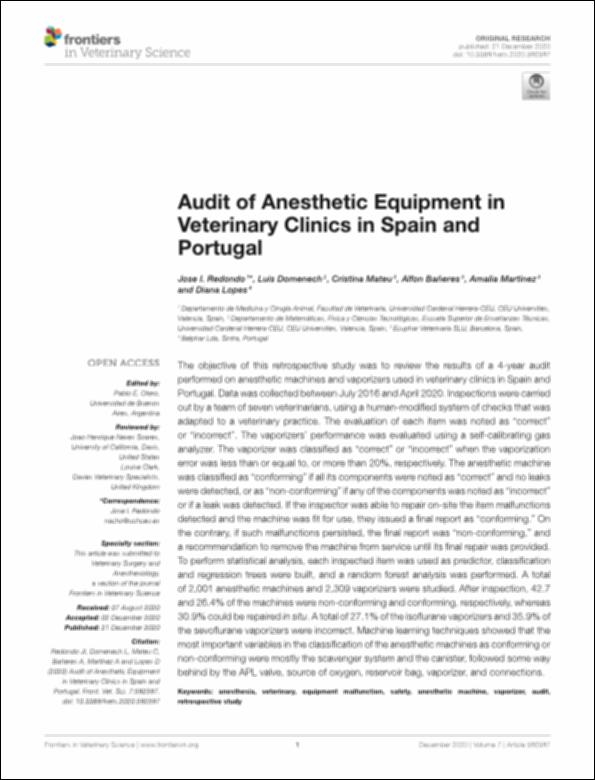Please use this identifier to cite or link to this item:
http://hdl.handle.net/10637/12611Audit of anesthetic equipment in veterinary clinics in Spain and Portugal
| Title: | Audit of anesthetic equipment in veterinary clinics in Spain and Portugal |
| Authors : | Redondo García, José Ignacio Doménech Ballester, Luis Mateu Montesinos, Cristina Bañeres de la Torre, Alfonso Martínez Jacobe, Amalia Lopes, Diana |
| Keywords: | Veterinary anesthesia - Equipment and supplies.; Clínicas veterinarias - Aparatos y material.; Analgesia (Veterinary) - Equipment and supplies.; Analgesia veterinaria - Aparatos y material.; Anestesia veterinaria - Aparatos y material.; Veterinary hospitals - Equipment and supplies. |
| Publisher: | Frontiers Media. |
| Citation: | Redondo, J.I., Domenech, L., Mateu, C., Bañeres, A., Martínez, A. and Lopes, D. (2020). Audit of anesthetic equipment in veterinary clinics in Spain and Portugal. Frontiers in Veterinary Science, vol. 7, art. 592597 (21 dec.). DOI: 10.3389/fvets.2020.592597 |
| Abstract: | The objective of this retrospective study was to review the results of a 4-year audit performed on anesthetic machines and vaporizers used in veterinary clinics in Spain and Portugal. Data was collected between July 2016 and April 2020. Inspections were carried out by a team of seven veterinarians, using a human-modified system of checks that was adapted to a veterinary practice. The evaluation of each item was noted as “correct” or “incorrect”. The vaporizers’ performance was evaluated using a self-calibrating gas analyzer. The vaporizer was classified as “correct” or “incorrect” when the vaporization error was less than or equal to, or more than 20%, respectively. The anesthetic machine was classified as “conforming” if all its components were noted as “correct” and no leaks were detected, or as “non-conforming” if any of the components was noted as “incorrect” or if a leak was detected. If the inspector was able to repair on-site the item malfunctions detected and the machine was fit for use, they issued a final report as “conforming.” On the contrary, if such malfunctions persisted, the final report was “non-conforming,” and a recommendation to remove the machine from service until its final repair was provided. To perform statistical analysis, each inspected item was used as predictor, classification and regression trees were built, and a random forest analysis was performed. A total of 2,001 anesthetic machines and 2,309 vaporizers were studied. After inspection, 42.7 and 26.4%of the machines were non-conforming and conforming, respectively, whereas 30.9%could be repaired in situ. A total of 27.1%of the isoflurane vaporizers and 35.9%of the sevoflurane vaporizers were incorrect. Machine learning techniques showed that the most important variables in the classification of the anestheticmachines as conforming or non-conforming were mostly the scavenger system and the canister, followed some way behind by the APL valve, source of oxygen, reservoir bag, vaporizer, and connections. |
| Description: | Este artículo se encuentra disponible en la siguiente URL: https://www.frontiersin.org/articles/10.3389/fvets.2020.592597/full |
| URI: | http://hdl.handle.net/10637/12611 |
| Rights : | http://creativecommons.org/licenses/by/4.0/deed.es |
| ISSN: | 2297-1769 (Electrónico). |
| Issue Date: | 21-Dec-2020 |
| Center : | Universidad Cardenal Herrera-CEU |
| Appears in Collections: | Dpto. Medicina y Cirugía Animal |
Items in DSpace are protected by copyright, with all rights reserved, unless otherwise indicated.


